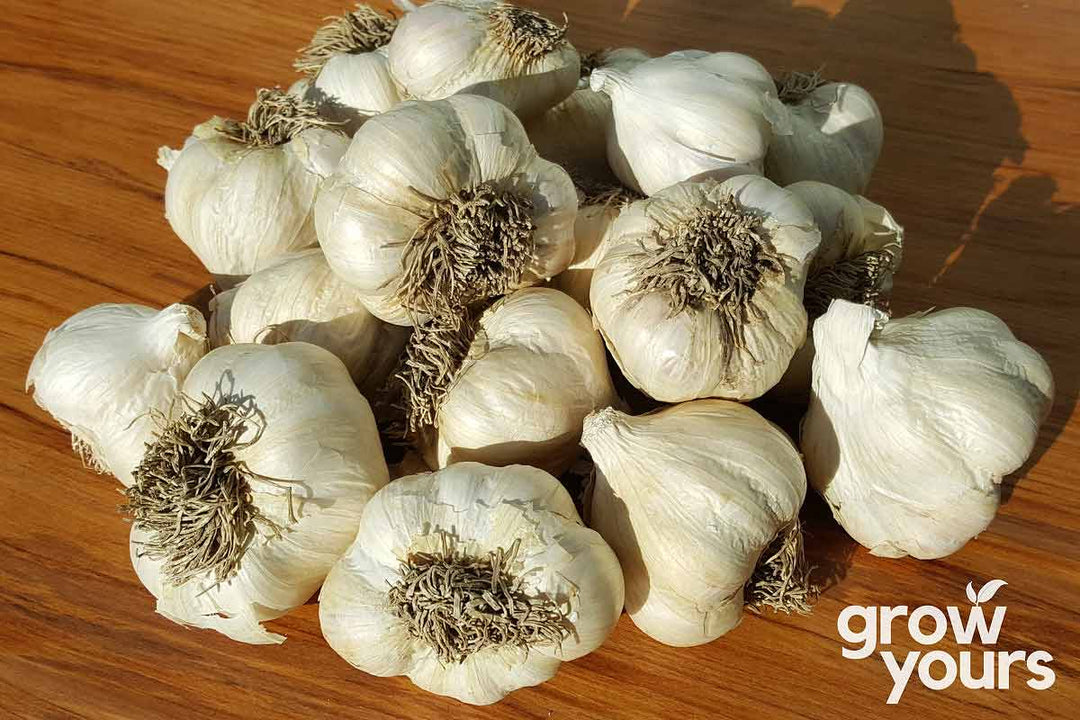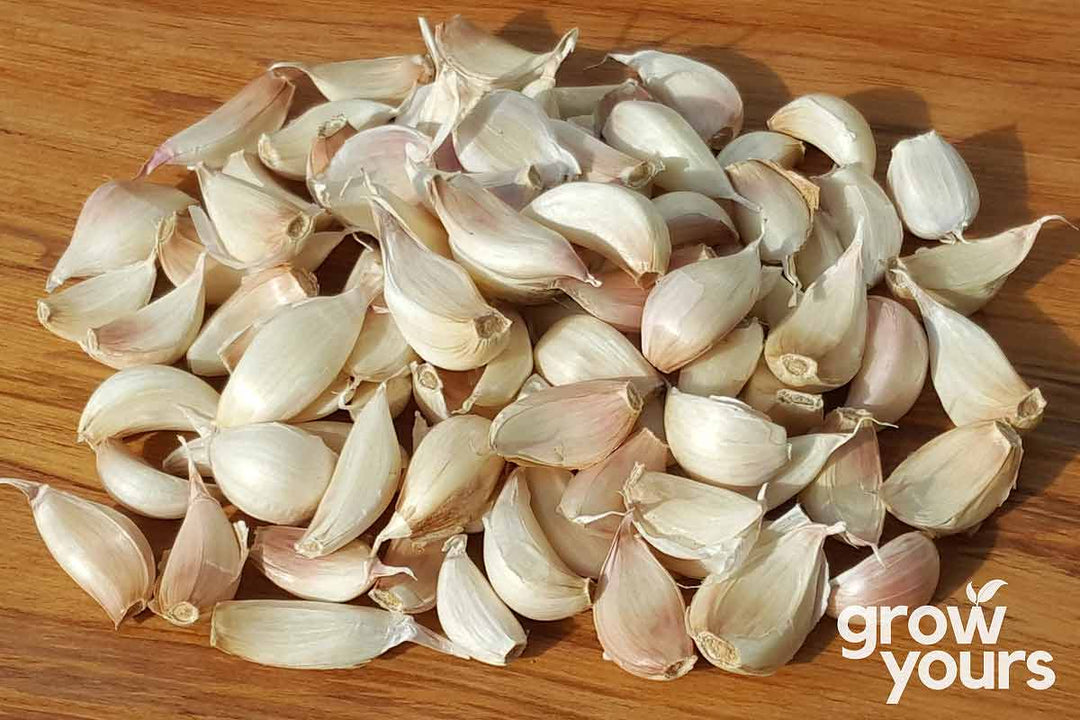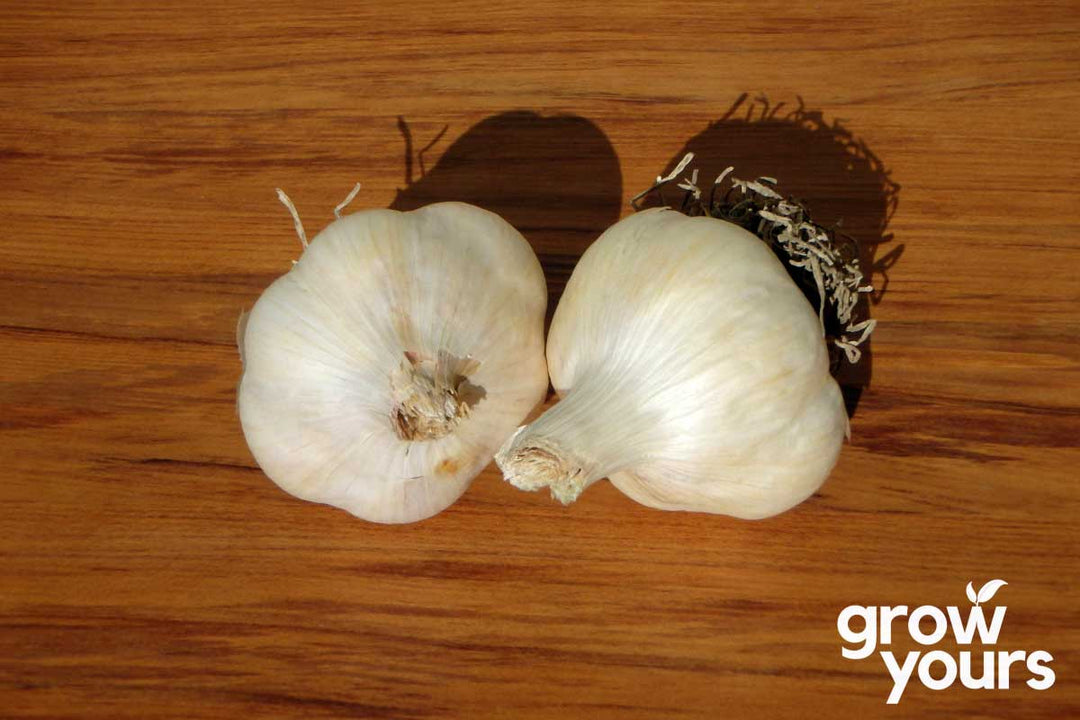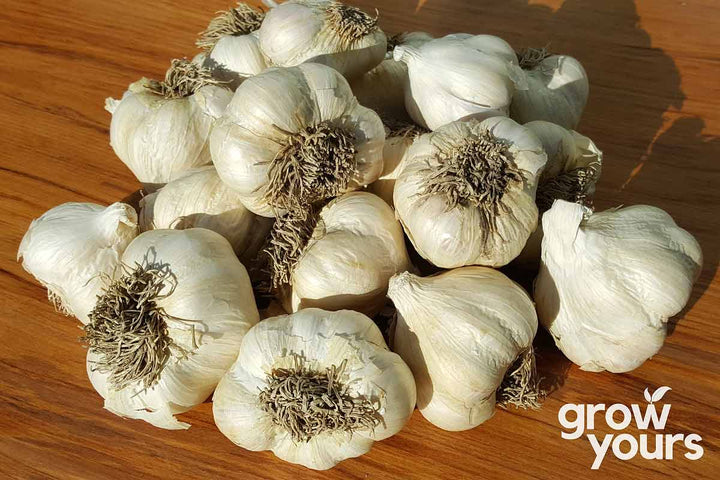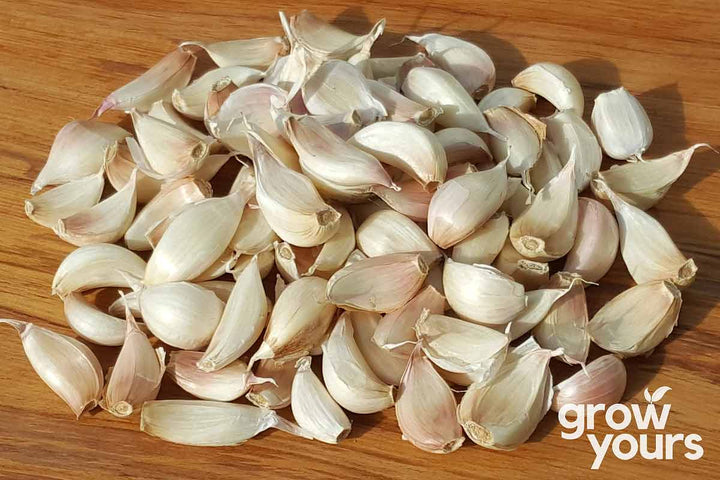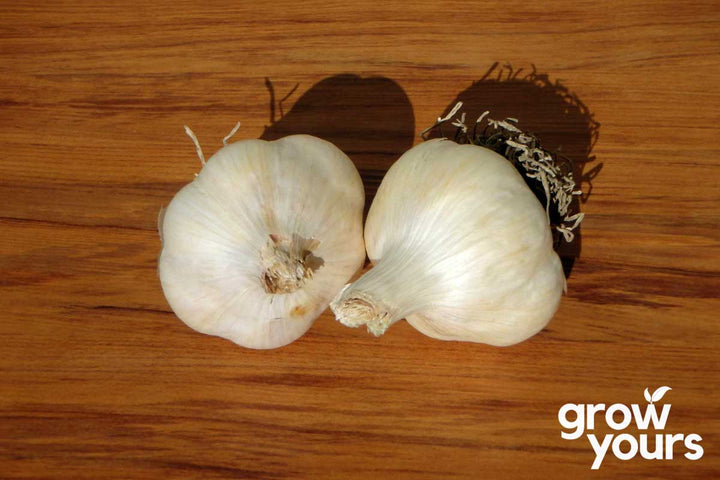Garlic ‘Printanor’
- Fast shipping NZ wide
- In stock, ready to ship
- Inventory on the way
Botanical Name: Allium sativum
Lifecycle: Annual
Heritage: France
 |
 |
‘Printanor’ is a delicious white skinned Garlic preferred by many chefs.
It has mid to strong, impeccable flavour and is excellent for all garlic uses. The cloves are easy to peel and often display a rose pink blush.
Typically produces medium to large, firm bulbs filled with plump, tasty garlic cloves. Considered to be the main commercial variety and one of the most commonly grown garlics in home gardens around NZ.
A French heirloom softneck variety that has been grown popularly in NZ since the 1980’s. It is simple to grow and keeps well for about 9 months or more.
SOWING:
 |
 |
|
Autumn - Winter |
Sow Direct, or Transplant |
Garlic is best sown in autumn and winter. Carefully break whole bulbs into individual cloves for planting, and sow pointy side up.
 |
 |
| 0°c - 10°c | 21 - 28 days |
Cloves are typically sown directly in place 50mm below the surface, approx. 20cm - 25cm apart when soil temperatures are between 0°c – 10°c, however they can also be sown in trays for transplanting.
 |
 |
 |
| 20cm - 25cm | 155 - 190 days | Hardy |
TIPS:
Garlic is a heavy feeder that enjoys full sun and requires fertile soil to perform at its best and produce big fat bulbs. That means in order to get the best results from your garlic patch it should be planted in well-fertilised free draining soil.
We recommend preparing your garden beds in advance of planting by generously adding lots of organic matter such as aged compost, potting mix, and/or manure a few weeks in advance of sowing your garlic. A layer of mulch on top of your garden bed is also great for insulating the developing garlic bulbs from extreme temperature changes over the growing season.
If you have access to lots of free organic matter from your yard such as a compost bin or dropped leaves that's perfect for layering generously in the garden for your garlic.
If you haven't found it easy to add heaps of organic matter to your garlic growing beds then a trick employed by large commercial growers is to dig or trench down 200-300mm at planting time and add sheep pellets or guano or bone flour to the bottom of the hole/trench at a rate of roughly 100g per lineal metre (a small handful each hole). Fill in the hole/trench with loose soil to form a cushion for your garlic cloves to sit on when you plant them, leaving about 50mm from the top of the hole for planting. Plant your cloves at 200mm – 300mm apart with the pointy side up/tip up with approx. 50mm - 75mm of soil covering the planted tips of each clove, and fill your hole/trench back up.
Garlic needs lots of balanced nutrients throughout the growing season including at the very end of the season when it fattens up the bulbs. Keeping this in mind, one final trick you can try is to sprinkle a balanced bulb food or general fertiliser over the top of your planted garlic row/s at 100g per lineal metre. Preferably use a blend/fertiliser that’s not too high in nitrogen, ideally the P (Phosphorus) & K (Potassium) values are close to the N (Nitrogen) value in the N-P-K ratio, because garlic needs phosphorous and potassium to fatten the bulbs and form its protective skins.
The biggest and fattest cloves around the outside of your garlic bulb will typically produce the best plants. Many people simply eat the smaller inner cloves but they can be planted too. Aim to sow your cloves the same day they are broken apart from their bulbs, as this process breaks their dormancy and they also will begin to dehydrate once broken apart.
Adequate spacing appears to be one of the simplest methods for dealing with rust, as plants spaced closely together can be devastated much more easily.
Garlic can be sown from April – August in New Zealand. Traditionally garlic was sown on the shortest day of the year in June and harvested on the longest day of the year in December, but the current trend is to plant slightly earlier in an effort to beat the arrival on rust in spring.
If birds or other animals are prone to disturbing your freshly sown garlic cloves, cover with netting or wire mesh until the cloves have put up their green shoots a few weeks later.
It’s ready to harvest when the tips of the leaves begin to yellow and the base of the stem goes soft. About a month before harvest you should reduce watering to improve the keeping quality of your garlic and help the bulbs focus on swelling.
Please note that garlic bulbs for sowing are only available during autumn and winter each year.
For more tips to growing garlic successfully in NZ read our blog post here.
GARLIC BULBS PER PACKET:
| MIXED GRADE ($9.90) | 3 bulbs (mixed grade) |
| LARGE GRADE ($13.00) |
2 bulbs (large grade) |
We offer shipping New Zealand wide. We aim to ship all orders as quickly as possible once payment has been received.
We do our best to ensure that orders placed by 12pm on business days will typically be shipped same day, however during peak times this may not be possible. Please note we're currently very busy but we'll have all orders shipped asap.
Please note that heavy items like seed potatoes cost significantly more to ship than small seed packets, so our shipping rates are on a sliding scale accordingly.
SHIPPING RATES
All orders are subject to a shipping and handling charge, outlined as follows:
Free Shipping Offer: We are currently offering free shipping on all orders $60 and over.
Urban Courier Delivery (0kg-1kg): $4.50
Urban Courier Delivery (1.01kg-3kg): $7.00
Urban Courier Delivery (3.01kg-5kg): $9.50
Urban Courier Delivery (5.01kg-7kg): $12.00
Urban Courier Delivery (7.01kg-10kg): $16.00
Rural via Standard Post (max. 150g): $4.50
Rural Courier Delivery (0kg-1kg): $7.00
Rural Courier Delivery (1.01kg-3kg): $9.50
Rural Courier Delivery (3.01kg-5kg): $12.00
Rural Courier Delivery (5.01kg-7kg): $16.00
Rural Courier Delivery (7.01kg-10kg): $20.00
We reserve the right to adjust any order where an incorrect shipping and handling charge has been applied, and to adjust our shipping rates as required.
ISSUES WITH SHIPMENT
In the unlikely event there is an error in your order we will correct this for you as soon as possible. Please ensure to check your order as soon as you receive it and inform us of any errors within 24 hours.
Our customers typically receive their orders within a few days of ordering, so if you have not received your order within 7 days please let us know immediately and we will follow this up for you. If your order has gone missing during transport we will make a claim with our shipping provider, which needs to be done within 14 days of dispatch.
Botanical Name:
This is the formal scientific name for each plant, firstly identifying the genus and then the species to which it belongs.
The purpose of these Latin names is to have a single name that is accepted and used worldwide for a particular plant or plant group, and to help distinguish each plant uniquely from other plants.
Lifecycle:
This refers to the typical lifecycle of each plant.
Annual: Plants that complete their life cycle within 1 year (from germination to growing and producing seeds, then dying).
Biennial: Plants that complete their life cycle in 2 years (germinates and grows in the first year, then produces seeds and dies in the second year).
Perennial: Plants that have a life cycle of more than 2 years.
It is wise to consider the lifecycle of each plant before choosing its final growing position. For example, you may prefer to plant perennials away from annuals, so your perennials are not disturbed when your annuals are harvested at the end of their relatively short lifecycle.
Heritage:
This refers to the geographic region and approximate date of origin, as it is best known for each variety.
Please note that varieties listed as “pre 1900’s” are very old varieties that have often been grown for hundreds of years, and as such their specific dates of origin are hard to list accurately.
Best Sown:
This refers to when it is suggested the seeds are best sown, to encourage strong and vigorous growth in their ideal seasonal conditions.
Please note that while some varieties may be able to be sown outside the range suggested, they will generally perform best when sown in the approximate seasonal ranges provided.
Sowing Method:
This refers to the suggested method for sowing each variety. Using the appropriate sowing method will help to ensure you achieve best results.
Direct Sow: These are seeds that perform well when sown directly into your garden. These seeds normally produce fast growing and strong seedlings. Please note that young seedlings may still need some protection from harsh weather and pests.
Transplant: These are seeds that perform well when started in trays or containers and then transplanted to their final position once they’re a bit stronger. These seeds often produce slower growing and weaker seedlings that need some care and protection from weather and pests. Seedlings can typically be transplanted to their final position once they are large enough to handle (for example 5+cm tall with several true leaves).
Please note that for varieties where we list both methods you have the choice.
Soil Temp To Germinate:
This refers to the approximate soil temperature range for optimum germination of the seeds.
Please note that while some germination may occur outside these ranges, the seeds will typically germinate strongest when sown in the optimum soil temperature range provided.
Approx. Time To Germinate:
This refers to the approximate amount of time it takes for the seeds to germinate.
Please note that while some variation may occur, with ideal conditions this represents an average amount of time before germination. This relies in part on the seeds being sown in soil at an ideal temperature for germination, per the heading above.
Spacing For Seedlings:
This is the recommended spacing between plants in their final growing position.
Please note that spacing plants closer together than suggested will likely result in underperforming plants, due to crowding and over-competition for root space and available nutrients.
Approx. Time To Harvest:
This is the number of days until the plant typically reaches the purpose for which it is normally grown. For example, this is the time it takes for the plant to fruit or flower, or until the leaves are ready to be picked, etc.
Please note that while this refers to the beginning of harvesting time, the plants could keep growing for an extended period yet, particularly if kept well looked after.
Hardiness To Frosts:
This refers to how tolerant the plant is of frost and cold weather.
Tender: Plants that will be injured or killed by frost and cold weather. These plants will probably not survive winter.
Half-Hardy: Plants that will not tolerate severe frosts, but should otherwise survive winter.
Hardy: Plants that have the ability to survive frost and cold weather. These plants should survive winter.




